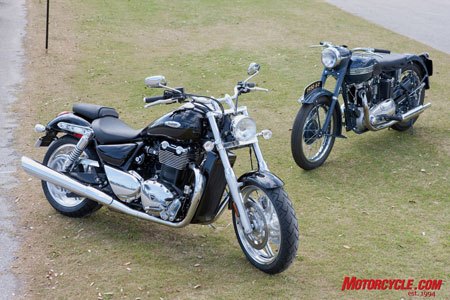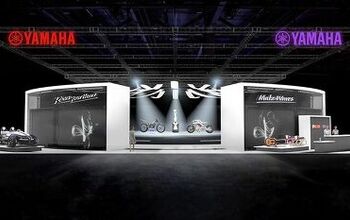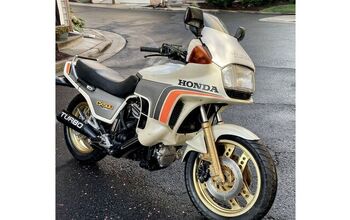2010 Triumph Thunderbird Review - Motorcycle.com
Get the Flash Player to see this player.
But now comes along a new cure for the common cruiser, an RC Cola of sorts. Or, perhaps more accurately, a Virgin Cola.
With its new Thunderbird, Triumph enters the competitive cruiser segment with a parallel-Twin powerplant unique in this category, and this makes the T-Bird stand apart from the typical cruiser hordes.
“We never considered (making) a V-Twin,” said product manager Simon Warburton at the bike’s launch in Barcelona, Spain. In fact, Triumph decided in the early 2000s that its future will consist only of three-cylinder and parallel-Twin motors.
Instead of using a V-Twin, something Triumph describes as “hackneyed,” the T-Bird uses a 1597cc vertical-Twin powerplant that is an exceptionally clean lump for a liquid-cooled engine. A 270-degree firing interval essentially turns the motor into a 0-degree V-Twin, if you will. Double overhead cams and four valves per cylinder enhance breathing and combine with an oversquare 103.8 x 94.3mm bore and stroke to enable fairly high (for a Big Twin) 6500-rpm rev limit.
This all-new “T-16” engine, at 98 cubic inches, is the world’s largest production parallel-Twin motor. Thumps from the 800cc pistons are quelled with twin balance shafts (front, rear) plus a crank-mounted torsional damper. Triumph claims this new mill pounds out a claimed 85-hp peak at 4850 rpm when measured at the crankshaft. Torque crests at 2750 rpm with an alleged 108 ft-lbs.
Aside from that parallel-Twin affront to Big Twin cruiserdom, the T-Bird plays the rest of the game in a straightforward manner. A twin-spine steel-tube frame uses the engine as a stressed member for a stout platform within its fairly tidy 63.6-inch wheelbase, 0.6 inch shorter than the Harley Dyna Super Glide Custom that Triumph used as one of its targets. A beefy 47mm Showa fork is raked out at 32 degrees with 151mm of trail, while dual Showa shocks with 5-position preload adjustability (wrench under the seat) anchor down the back end.
There’s no such thing as a viable cruiser with a tall seat height, so the T-Bird boasts a wide and well-padded saddle 27.6 inches above the ground (same as the Dyna), and this ensures a cruiser-typical feet-forward riding position. The handlebar greets hands a bit further forward than some laid-back cruisers, putting a rider’s spine in a comfortable position slightly rotated forward. A pleasantly tight turning circle is an unexpected bonus.
There’s also no such thing as a viable cruiser that’s ugly, so the UK-based Triumph turned to an American designer to define how an inline-Twin cruiser should look. Tim Prentice, who has styled the Honda Rune, Yamaha Road Star and Triumph Rocket 3 Touring, spent the bulk of three years working on the T-Bird project with Triumph. Clean lines and the remarkably uncluttered liquid-cooled engine are its highlights. Its fuel tank, though curvaceous and seamless, seems to sit a little too high because of clearance needed for the engine’s vertical cylinders. For more insight into the T-Birds styling, check out an interview with Prentice.
Punching the e-start button brings forth a starter noise eerily familiar to Harley owners, and it’s followed by quick light-off thanks to electronic controls that treat each cylinder independently for fuel and ignition mapping as part of a closed-loop system with twin oxygen sensors and catalytic converters. Cylinders are fed by 42mm throttle bodies that are graced with stylized horizontal finning to mimic the machined fins cut into the upper cylinders.
Twin-skinned chrome stainless-steel header pipes push spent gasses through an under-engine collector before shuttling their way through flared-out, megaphone-style outlets on each side. Thanks to the oddball 270-degree firing interval (instead of the usual 180- or 360-degree arrangement) the soundtrack chuffed out isn’t unlike the variety of cruiser V-Twins. Vibration is clearly felt but is subdued to inoffensive levels.
The T-Bird, at a stated weight of 756 lbs with its 5.8-gallon tank full of fuel, was never going to handle as friendly as a scooter, but it’s surprisingly compliant at low speeds. Clutch effort is relatively light, and the gearbox has short, positive throws that make it as snickety-snick as a big-inch cruiser tranny gets. Keeping things peaceful are helical-cut transmission gears (quieter than spur gears) and a belt final drive, the latter Triumph’s first since the 1920s.
Throttle response proves to be smooth in all conditions, thanks in part to the engine responding to one of two separate maps depending on how quickly the throttle is opened. The electronics realize that a slow twist of the throttle doesn’t require a big power response, so it uses a more conservative map for fuel and ignition, making the T-Bird docile when you want it to be. Grabbing a handful gives you the full-monty power map.
As one of the few cruiser engines with an oversquare bore/stroke ratio, it’s difficult to draw a clear bead on how the T-16 stacks up against other cruiser motors. It has the same claimed torque as the new Vulcan 1700, but the $12,299 Kawi’s peak arrives 500 rpm sooner and feels like it. Yet the Hinckley Twin has plenty of twist on tap near the bottom, and the vertical Twin’s 6500-rpm rev ceiling gives it some upper-rpm thrust where other cruisers have already hit their rev limiters. The T-16 does get a bit buzzy above 4000 rpm, but the tranny’s overdrive sixth gear keeps you away from those revs at cruising speeds.
The T-Bird’s cockpit proves to be a pleasant place to inhale horizons. The seat is wide and supportive, and its seams are taped to prevent water entry. The pillion seat is narrow (though removable), so you might want to browse Triumph’s accessory catalog (see sidebar below) if you value bringing a partner along for the ride. The pegs aren’t too much of a stretch for shortish legs (so some weight can be taken off a derrière) yet are still tolerable for long ones. Standard mirrors provide a clear view rearward, and self-canceling turnsignals are a welcome standard feature.
Trick Out Your TrumpetA bounty of accessories keeps customers happy and dealers in business, so Triumph has already developed a purported 100 new products for the Thunderbird, the most for any one Triumph model.
Like most cruiser lines, the T-Bird has a raft of optional bolt-on accessories that can transform a basic cruiser into a light-duty tourer. Removable windshields come in a variety of sizes and have a quick-detach system (as do the backrests) for swift conversions. You’ll also find luggage racks, 40-liter leather saddlebags and pounds of chrome.
But the coolest bolt-on is a 104ci (1700cc) big-bore kit. It includes new cams, pistons, liners, gaskets, beefier clutch springs and a new clutch cover that proclaims its “104ci” status. The $899.99 package requires about a day’s worth of installation time and remains EPA and Euro 3 legal. When combined with an accessory hi-po air filter, a new ECU map and not-quite-EPA-legal exhaust pipes, it yields a significant 17.6% bump in horsepower to an even 100 ponies. Torque goes up slightly from 108 to 115 ft-lbs.
We were able to sample the 104 for a few miles, and we were impressed with its extra liveliness throughout its rev band. Just as appealing is the extra soul being trumpeted out of the accessory slip-on exhaust pipes ($430 for shorties; $450 for long ones) that add some toughness without being obnoxiously loud. You can hear a couple of clips of them in our video – very appealing.
Instrumentation is contained in a tank-top console set into a chrome base. A switch on the right handlebar toggles through handy displays for a clock, two tripmeters, a fuel gauge and a miles-to-empty readout. And although there’s not much need for a tachometer on a cruiser, we’re happy to see one. On the downside, the tach’s small size and its placement at the bottom of the gauge panel means it’s difficult to read without looking down.
It took perhaps 20 minutes in the saddle before I began to take note of the ’Bird’s suspension, and that’s not something you can say when riding many other cruisers. Triumph did an impressive job of developing mid-grade, non-adjustable components to work in harmony with the chassis. There’s nothing fancy here – a steel swingarm and no damping provisions – but it provides a plush ride on the highway and still holds up well in the corners.
Speaking of which, the Thunderbird proved to be surprisingly adroit on the twisting roads climbing the mountain of Montserrat on the outskirts of Barcelona. Triumph in tandem with Metzeler developed new versions of the ME880 Marathon that are used on the T-Bird’s cast-aluminum wheels with machined faces on the spokes and rims. A 19-inch 120/70 leads the way, while a semi-fat 200/50-17 provides an imposing footprint without bunging up the bike’s handling. No, this isn’t going to chase down any Street Triples, but the cruising Trumpet boasts a willing chassis that allows a rider to throw it onto its peg feelers with confidence. The available lean angle won’t give vertigo to a sportbiker, but it has at least as much clearance as most other cruisers.
The T-Bird’s brakes stand out as special in this market. Dual 310mm rotors readily turn kinetic energy into heat, aided by the power from 4-piston Brembo calipers actuated by braided-steel brake lines. Together with a 2-piston Brembo and a same-size disc in the rear, Triumph’s “mainstream cruiser” sheds speed with relative ease. Strong front springs keep the fork high in its stroke and don’t allow it to dive as much as some cruisers. We also sampled the ABS version (an $800 option) that won’t enter production until July, and we found the front binders to be very effective at quick stops without much lever pulsation even if the anti-lock controls release the rear tire a little too easily.
Lots of good things to say about the Thunderbird, and just a few small nits to pick. Although helmet locks are fairly rare on cruisers, some sort of helmet retention strap would’ve been appreciated. A rider can feel some heat from the radiator at low speeds and when stuck in traffic, though it’s not oppressive. A gear-position indicator would be convenient. And, aesthetically, the non-chrome lower fork legs look unfinished next to the chrome slider cap and sliders – Triumph will do brisk business selling the accessory chrome legs in its catalog.
We came away from our ride on the new ’Bird more impressed than we thought we’d be. There are many estimable cruisers already on the market, but the Triumph matches or exceeds them in most dynamic qualities – acceleration, handling, braking.
The question that remains is if riders will be willing to perceive a liquid-cooled parallel-Twin motor as acceptable for a cruiser powerplant, whether mechanically or aesthetically. From the saddle, it’s challenging to perceive there isn’t a V-Twin engine between your legs, in terms of both sound and feel, which should please the intended audience.
But the fact this is an odd cruiser bird also makes it more appealing to riders who want to stand apart from the crowd. Its $12,499 MSRP nestles it neatly between the Vulcan 1700 and the H-D Dyna Super Glide Custom. The T-Bird is undoubtedly strong value for the money, so it will be interesting to see how many riders will be lured by its English charms.
So, when you’re thirsty, will it be a Coke, Pepsi or a Virgin?
Duke's Duds- Lid: HJC Sy-Max
- Jacket: Triumph Hawk
- Gloves: Shift Bullet
- Pants: Shift Torque Jeans
- Boots: Icon Motorhead
More by Kevin Duke






































Comments
Join the conversation